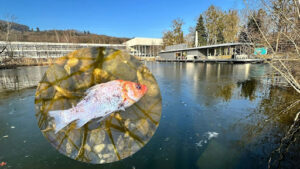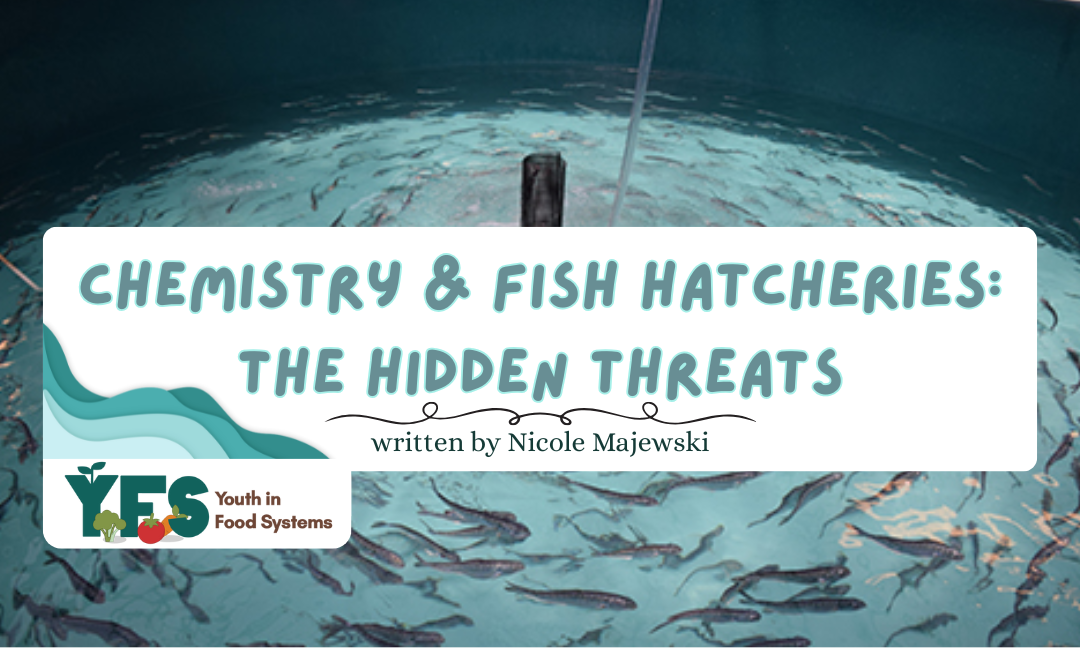Written by: Nicole Majewski
Edited by: Rayna Almas
Designed by: Eleanor Jeavons
Published by: Rayna Almas
In a time where protecting the environment is more important than ever, fish hatcheries serve as a fin-tastic way to do just that. These metaphorical nurseries offer a place for aquatic life like fish, crustaceans, and other species to be carefully hatched, raised, and bred. The goal is to give these creatures a strong start before we release them back into rivers and lakes, where they in turn support their populations! In the long run, this targeted restoration can prevent extinction by replenishing declining numbers and maintaining the delicate balance of our planet’s waterways.
There’s one problem, though. In fact, what if I told you that a single silent threat could unravel all this effort? That’s sadly not just a hooker.
While many people think of fish hatcheries as unstoppable solutions to fish conservation, these systems are actually very fragile. The very chemicals we use to manage these systems—or those that sneakily find their way inside—can have horrible consequences. Let’s dive into the surprising ways chemicals are impacting fish hatcheries and why this issue affects all of us.

The Problem: Contamination
The hidden dangers of chemicals come from two main sources; pollution and usage. Pollution is unintentional—it’s the process where harmful substances end up in unintended places, like hatchery waters. This can happen through agricultural runoff, where pesticides and fertilisers from nearby farms seep into the water supply, or through plastic and microplastic litter that breaks down into toxic particles. These contaminants aren’t meant to be in the hatchery water; they enter the system through outside sources. But it’s not just substances that unintentionally leak into the water that can be dangerous to the fish. Surprisingly, a large portion of the threats posed to fish by chemicals come from intentional efforts to introduce them into hatchery environments. That might seem confusing—why would we make fish interact with chemicals that we know are bad? Unfortunately, we don’t always know that. In fact, a lot of the evidence stating just that was only discovered by research over the past few years. So, a lack of awareness can be as dangerous as the chemicals themselves. To the hatchery workers, they’re using these substances for good reason, like to manage algae growth or control parasites. In reality, they can be fatal to more than just the parasites.
Take copper, for example. It’s used in many hatcheries, and hugely valued for its ability to fight certain diseases in fish. However, newer studies have found that there’s a catch—while copper may save fish from one sickness, it often does so at the cost of vital physiological functions. So, once these fish are released into the wild, they’ve already lost the instincts and abilities that they rely on to survive in an environment filled with predators and competition for food. It’s mind-boggling that all the care put into producing new fish for their populations could be undone by something that we didn’t even realise was happening until recently.
The Impacts
We aren’t talking about oil spills that coat fish in black sludge. Instead, the damage is often subtle, occurring through changes in behavior, senses, and internal functions. These seemingly small shifts can have huge consequences for a fish’s ability to survive and thrive.
Copper isn’t the only factor at play, though—different chemicals have different consequences, and there are a lot of chemicals. But we’re not just talking about oil spills that coat fish in inky black sludge. As we’re already emphasised, the effects of contaminants aren’t always visible. They can occur through subtle shifts in behaviour, senses, and internal functions. These seemingly small changes can have huge consequences on a fish’s ability to survive and thrive in the wild. Let’s dive deeper into some specifics:
- Behavioral Alterations: Fish behavior is incredibly sensitive to even the most subtle chemical changes in their environment. A specific group of chemicals called psychoactive pharmaceuticals, even in the tiniest of amounts, can have much larger effects. Some fish may become more anxious and less social, while the exact opposite occurs in others—like guppies becoming hyperactive when exposed to pesticides. This hyperactivity may sound harmless, but we’re talking about more than a sugar rush. It can override natural reflexes and hinder a fish’s escape responses, making them much more prone to taking risks that end with them being eaten by predators.
- Reproductive Failure: The success of a fish hatchery depends on the ability of fish to reproduce. Chemicals can interfere with this process to a worrying degree. Exposure to certain metals and pesticides can disrupt reproductive patterns, like nesting behaviors and standard mating rituals. In the long run, this can cause a dramatic decline in the number of eggs laid and offspring produced. This directly invalidates the purpose of a hatchery; to foster fish populations.
- Dysfunctional Senses: Fish rely heavily on their sense of smell to find food, avoid danger, and navigate. Chemicals can disrupt this essential function. For example, studies have found that even low levels of copper can completely block the parts of a salmon’s brain that control their sense of smell. Without this necessary sense, a salmon’s capability to locate food is severely reduced, which can cause malnutrition.
- Neurological Damage: Pollutants, especially microplastics, can cause what scientists call “neurological disruptions.” This means they interfere with the brain’s natural chemistry—disrupting the balance of neurotransmitters like serotonin and acetylcholine. This can result in reduced capabilities of movement, navigation, and coordination. Unfortunately, a fish that can’t swim straight or navigate its way through a river has little chance of survival.
But all of these changes don’t just impact fish, and their consequences don’t end when affected fish leave the hatchery. A fish that has lost its survival instincts, its sense of smell, or its ability to reproduce is a lot like a dead end, because even though it’s a new member of its species, it still can’t contribute to the ecosystem the way it needs to. These compromised fish often become easy prey, fail to find mates, and tragically end up doing very little to support the populations they were meant to save.
This problem threatens so much more than just fish. It has a ripple effect that can reduce the success of aquaculture, damage the entire food chain, and pick away at the biodiversity of our most important waterways.
The Future
Even though the implications of all of this can seem terrifying, there’s good news; awareness is the first step towards change! You’ve just taken that first step. By understanding the delicate ways that chemicals can harm fish, we can begin to advocate for better practices.
This means that, as new research helps us better understand the long-term effects of common hatchery chemicals, we can fight for stricter regulations to be put into place. It also means being mindful of the chemicals we use in our daily lives that can end up in our waterways. The future of our fish, our ecosystems, and our food systems depends on protecting fish hatcheries from the hidden threats they face.
References
American Fisheries Society. (2012). AFS Policy Statement #6: The Role of Fish Hatcheries in the Conservation and Management of Aquatic Resources. American Fisheries Society. Retrieved from https://fisheries.org/policy-media/policy-statements/afs-policy-statement-6/
Dixson, D. L., & Munday, P. L. (2015). The role of chemosensory cues in fish survival. Reviews in Fish Biology and Fisheries, 25(2), 241-262. https://doi.org/10.1007/s11160-015-9388-z
El-Sayed, A. F. M. (2015). Fish behavior and welfare under environmental stressors: A review. Journal of Applied Ichthyology, 31(3), 384-394. https://doi.org/10.1111/jai.12711
Evers, J. F., & Hanke, W. (2012). Olfactory toxicity in fish: An introduction. In G. G. P. L. K. K. P. A. L. N. M. B. J. H. T. (Eds.), Fish Olfaction and Behaviour (pp. 1-15). Nova Science Publishers. Retrieved from https://pubmed.ncbi.nlm.nih.gov/22697575/
Ecological death. (2023, June 20). In Wikipedia. https://en.wikipedia.org/w/index.php?title=Ecological_death&oldid=1160913936
Hanna, A. (2022, November 9). The fish are getting high on our anti-anxiety meds. Vox. https://www.vox.com/down-to-earth/407949/anti-anxiety-depression-medication-wildlife-salmon
Heute. (2025, February 26). Wasser wird untersucht – Rätselhaftes Sterben – Dutzende tote Fische im Teich [Photograph]. Heute.at. https://www.heute.at/s/raetselhaftes-sterben-dutzende-tote-fische-im-teich-120093073
Kou, Y., Luo, W., Zhang, B., Liu, J., Peng, Y., Wang, F., & Song, X. (2022). Neurobehavioral toxicity of triclosan on crucian carp (Carassius carassius) and its underlying mechanisms. Environmental Science and Pollution Research, 29(47), 71146-71156. https://doi.org/10.1007/s11356-020-09862-2
Lem, E. C., Arbuckle, A., Kincaid, C. S., & Arbuckle, M. A. (2022). The neuroethological effects of anthropogenic pollution on fish. Philosophical Transactions of the Royal Society B, 377(1859), 20220503. https://doi.org/10.1098/rstb.2022.0503
Martins, D. A., Zaleski, T., Viana, S., Rodrigues, M. P., & Ferreira, M. (2019). Behavioral and neurobiological responses of fish to chemical stress: A review. Journal of Fish Biology, 94(1), 1-15. https://doi.org/10.1111/jfb.13840
Olfactory toxicity in fish. (2023, June 17). In Wikipedia. https://en.wikipedia.org/w/index.php?title=Olfactory_toxicity_in_fish&oldid=1160492823
Roberts, P., & Drouillard, K. G. (2014). An updated review of fish ecotoxicity and risk from pharmaceuticals and personal care products. Environmental Toxicology and Pharmacology, 38(2), 522-540. https://doi.org/10.1016/j.etap.2014.06.012
Sharma, M. (2019). Behavioural responses in effect to chemical stress in fish: A review. Journal of Aquatic Research and Development, 33(1), 1-10. Retrieved from https://www.researchgate.net/publication/330090387_Behavioural_responses_in_effect_to_chemical_stress_in_fish_A_review_Madhu_Sharma
Steel, R., Dworatzek, S., & Van der Heijden, P. (2023). A review of current research on the effects of copper in fish hatcheries and the environment. Water, 8(6), 311. https://doi.org/10.3390/water8060311
Zlatković, J., Subotić, G., & Drobac, M. (2016). Effects of chemical stressors on fish health: A review of the main pathways and mechanisms. Journal of Environmental and Public Health, 2016, Article ID 4583273. https://doi.org/10.1155/2016/4583273

